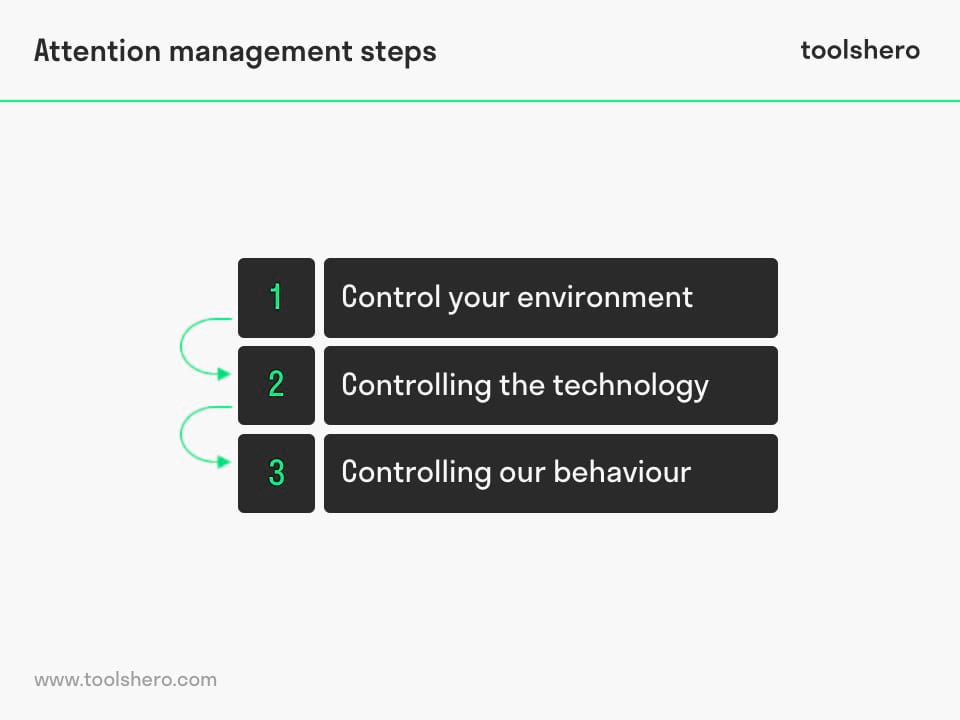Attention Management by Maura Thomas

Attention Management: this article explains Attention Management, co-developed to the 21st century by Maura Thomas in a practical way. This article contains a general definition of Attention Management, three steps in daily life in the 21st century, the Attention Management Scale, the Problems and Attention Habits and Attention Management in Private Life. Enjoy reading!
What is Attention Management? The definition and basics
Attention Management can be defined as the process to support individual or collective attention in real time that can be long term such as periods of weeks or months to focus on some goal to be met, either in professional or personal surroundings.
Attention Management is about the ability to manage the distractions that pollute people’s environment and cause them to be unproductive or fail to deliver quality results.
Attention Management is more than the perception that we have of focusing on something, it is the ability to control your attention and to be able to choose where it is going to be directed. It is being more proactive and less reactive.
Human beings are being distracted all the time, both by internal and external factors. These distractoins can easily lead them out of focus from their duties and responsibilities, which is why Attention Management facilitates the control of neglect in order to generate good quality results that the person wants and needs to achieve.
The human attention span is limited because of the brain, since the brain is the connector that facilitates attention. It is much more difficult to multitask and get a positive result on all of them or to be completely satisfied with the results.
Attention Management receives more attention, now that more and more employees are working from home. Attention Management offers multiple management strategies to create a balanced and productive work enviroment.
Background of Attention Management
There is a lot of information, and humans are not able to process correctly or cannot capture completely everything. Attention is limited to the processing of the brain. According to Mihaly Csikszentmihalyi, the processing capacity of the human conscious mind is 120 bits per second, listening to one person is about 60 bits per second of processing, this means that it is difficult to understand two people talking at the same time.
When distractions are attended by a person, there is no closure from the previous task. As this happens multiple times a day, a person gets burried in workload. This is also known as attention residue.
Attention is also limited by the mental fatigue in the process people need to generate to focus on daily activities. This is limited by the neurons and leads to the above-mentioned mental fatigue.
Apart from the brain process for Attention Management, happiness is also a factor in productivity in the work field and the concentration needed. Paul Dolan says that attention is an essential component to improve personal well-being and to be able to have a good attention to the activities that are being performed.
Attention Management has become the most important tool for the 21st century according to Maura Nevel Thomas, who emphasizes that time management is secondary and Attention Management is more important for producing good quality work.
According to Thomas, putting something on the calendar does not mean it will be done, nor does it mean it will be attended to. Maura Nevel Thomas is the author of Attention Management How to Create Success and Gain Productivity Every Day, international speaker, TED speaker and business trainer for Productivity Empowerment.
Attention Management in daily life in the 21st century
People nowadays live in a century where distractions are much easier to obtain than they were in previous decades. Technology has been a valuable resource for humanity in terms of development, productivity and communication, however, the use of electronic devices makes us lose focus in our work since we are always connected either with the computer or the cell phone at hand.
This is why Maura Thomas discusses the importance of Attention Management at any time in life. There are three steps to Attention Management according to her:

Figure 1 – Steps in Attention Management
- Control your environment
- Controlling the technology
- Controlling our behaviour
1. Controlling the environment
It is important to be able to be comfortable with the environment you are in when you need to focus on what is important. It is possible to find a quiet place, close the office door or have effective communication with your team so that you are not interrupted and stay focussed unless it is vital.
2. Controlling technology
It is possible to silence our mobile or turn off some applications to eliminate distractions for the time we really need to focus on. This can be done for 20 minutes at certain times of the day and then gradually be able to detach from the technology as a term of unnecessary distraction.
3. Controlling our behaviour
This is the most difficult part because it is more complicated to put our thoughts in order or what can distract us from our environment. This can be achieved by practicing it constantly, you can exercise your concentration muscle. People learn to control our internal distractions.
Technology, although sometimes it can be a problem, is important to emphasize its importance in the effectiveness and ease of performing our tasks, thus being much more agile. This means that technology goes from being a distraction to being an essential tool for our working life.
Attention Management Scale
With technology everywhere around, it is common to create distracting habits such as looking at a mobile phone to see if messages are coming in, leaving our online status of availability, mail and social networks open among others.
These habits come back every day, and can become increasingly obsessive over time and it becomes difficult to give up this behaviour, even in the personal sphere.
It is necessary to have a balance in which this type of distractions can be balanced both in the work and personal environment, where each person sets limits that allow productivity at work or in the personal sphere (family, friends, hobbies).
An example of what can become compulsive is the way the boss behaves with his work team. If a boss tends to send messages during non-work hours, he makes his employees active by checking the messages that his leader sends and this also makes him find a distraction when he should not because people are in their private moment of the day with family or friends or simply resting.
The leader must keep in mind the initiative and control of Attention Management for his or her team.
Problems and Attention Habits
- Multitasking
- Open messages when not needed
- Constantly changing habits (opening documents at once, downloading, checking emails)
- Cognitive limitations of perception
- Overloading of information
- Overload of social interaction (social networks)
- Residual attention (stopping to do something to focus on a secondary task)
According to Maura Thomas, it is important to keep in mind the importance of Attention Management and its constant practice. The first step is recognizing what distracts people from their work. The next step is to prevent those distractions from happening in order to stray focussed.
Attention Management in Private Life
The vitality of Attention Management is not only important in the work field but also in the private life. Thomas calls it “Life Flow” since life does not only revolve around our profession but also our personal daily life. In our personal life there are several responsibilities that must be addressed.
External Distractions from Attention Management
Studies have shown that productivity at work can be influenced by things like the weather. If the weather is bad, productivity can increase because thoughts are more focused on work, but if it is a sunny day, distracting thoughts can easily come as the desire to be outdoors, enjoying the good weather, can be the external distraction experiment.
Internal factors
Thoughts and lack of motivation with respect to the task being performed as the process will be slower or unsatisfactory in the sample of results. The energy to perform activities is important as motivation can focus attention on responsibilities.
Conclusion
Nowadays, distractions can easily be found in everyday life, both in the professional and personal life. Many of these distractions are connected to aspects connected to technology. Technology is used as a productive mechanism to facilitate daily tasks (research, communication, information etc) however, it can also be a great distraction from the responsibilities that are required.
Attention Management is a tool that is not based on time, but on the management of concentration and practice of habits that can help to be productive and dynamic in a positive way to generate the actions we need to do in our work and personal activities. An example of a productive habits is breaking down tasks and the establishment of so-called stopping points. These are pre-determined points at which one stops working at the task.
The fulfilment of objectives is important, for this it is necessary to put priorities in the management of attention. It is advisable to make a list of tasks and not to focus on multitasking for efficient and fast productivity of things. Doing several things at once is possible but it does not mean that the processes are fine or that the results will be more positive.
Recreation is also related to Attention Management because it is crucial for mental well-being. It is necessary to have moments of mental recreation where the mind can relax in order to focus on what is needed. When you are in peace, that is the time when ideas can come up most easily and you can enter into productivity by taking them into action.
It’s your turn
What do you think? Is Attention Management still important today for professional productivity? Do you use Attention Management in your daily life? What are your strategies and have they worked for you? Do you have anything else to add?
Do you have anything else to add or any suggestions?
Share your experience and knowledge in the comments box below.
More information
- Davenport, T. H., & Völpel, S. C. (2001). The rise of knowledge towards attention management. Journal of knowledge management.
- Green, C. A., Salinger, J. A., Tsimhoni, O., & Raphael, E. L. (2016). U.S. Patent No. 9,235,987. Washington, DC: U.S. Patent and Trademark Office.
- Elomaa, M. M., Williams, A. C. D. C., & Kalso, E. A. (2009). Attention management as a treatment for chronic pain. European Journal of Pain, 13(10), 1062-1067.
- Lemmey, T., Surin, N., & Vonog, S. (2015). U.S. Patent No. 9,049,033. Washington, DC: U.S. Patent and Trademark Office.
How to cite this article:
Ospina Avendano, D. (2020). Attention Management. Retrieved [insert date] from Toolshero: https://www.toolshero.com/personal-development/attention-management/
Original publication date: 06/22/2020 | Last update: 11/20/2023
Add a link to this page on your website:
<a href=”https://www.toolshero.com/personal-development/attention-management/”>Toolshero: Attention Management</a>












